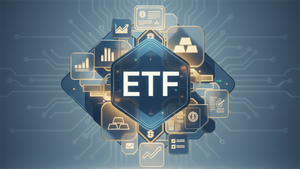The Revelation of Decentralized Finance (DeFi)
It's a well-known lament: conventional investment vehicles are constrained by notoriously meager returns. Standard savings accounts and term deposits rarely see Annual Percentage Yields (APYs) exceeding four percent, according to financial tracking agencies.
Enter a revolutionary set of tools: Decentralized Finance (DeFi). These options deliver significantly greater profitability, with average returns hitting 60% to 80% APY, and recorded instances of gains far surpassing that—meaning your capital can double (a 100% return).
Forecasters predict the DeFi ecosystem will swell to a $450 billion market by 2030. Many financial strategists consider this estimate conservative, particularly when juxtaposed with the global bond market, which exceeds a staggering one hundred trillion dollars.
DeFi is simply the abbreviated term for "Decentralized Finance." Traditional finance is the application of capital to create more wealth, typically through lending or investment, with a heavy reliance on central authorities like banks. DeFi strives to execute these same financial functions while bypassing institutional intermediaries as much as possible.
To truly grasp DeFi, one must be acquainted with its core components: tokens and protocols. This is the focus of the section, "DeFi in Practice: How is Wealth Generated?" You are welcome to skip directly to that discussion or first review the factors accelerating DeFi adoption and the inherent risks that demand caution.
For those eager to understand the mechanics of profit generation, proceed directly to "Profit Amplification Strategies." Here, you’ll be introduced to initial concepts and given the opportunity to share your contact information to receive updates on forthcoming entries in this educational series. If your interest lies specifically in the analytical software we are developing to enhance your earnings, the sixth section provides details and a sign-up option.
A substantial portion of the insights presented here are credited to Alexandra Damsker's excellent volume, Understanding Defi.
Finally, it must be acknowledged that engaging in DeFi constitutes an investment activity, comparable to launching an enterprise or buying a CD. Consequently, you must exercise fiscal responsibility and maintain a state of constant alertness regarding the capital you commit.
Shifting Focus: Why Bypass Banks for DeFi?
A primary engine driving the expansion and adoption of the DeFi sector is a pervasive distrust of traditional banks. This resentment stems mainly from the fact that banks utilize public funds to amass vast fortunes without reciprocating a reasonable share of the income.
Another point of contention is the disparity in legal treatment between financial institutions and private citizens. An average person who cannot service their mortgage faces foreclosure. Conversely, history shows numerous instances where governments rescue banks that have acted irresponsibly with client money.
The 2008 banking collapse is a classic illustration. The recklessness of financial giants triggered a systemic global crisis, culminating in the $700 billion Emergency Economic Stimulus Plan (the "bank bailout," extended to General Motors and Chrysler) and a further $780 billion in stimulus via the American Recovery Investment Act in 2009. Flawed and high-risk lending practices devastated everyone except the banks.
A more contemporary example is the crisis involving Silicon Valley Bank (SVB). This incident revealed not only poor banking practices—in a bank that held deposits far exceeding the $250,000 insurance limit for countless tech entrepreneurs—but also regulatory failures. Greg Becker, the former SVB CEO, aggressively lobbied to exempt SVB from the oversight imposed by Dodd-Frank, claiming compliance added unnecessary expense. Before its final collapse, Becker sold his stock and personally contacted clients to "assure them their money was safe."
The Reality of Risk: Are Scams Present in DeFi?
Regrettably, the answer is yes. This reality is precisely why the alchemy145 team initiated this content series, where we will share our perspectives on DeFi, our investment choices, and the support software we develop. High average returns do not negate the necessity of exercising caution.
Some high-profile failures were rooted in flawed architectural design, not malicious intent, such as Anchor, an investment protocol where tokens were merely deposited without a viable mechanism for value accrual.
Voyager represents another notable failure. A severe drop in token valuations, precipitated by Federal Reserve interest rate hikes, led to a liquidity crunch for funds heavily exposed to digital assets. Defaults across the industry created a detrimental cascade effect, overwhelming lenders like Voyager.
Extreme care is also required concerning token storage locations and the exchanges used for transfers. The FTX scandal is well-known: this venture capital-backed exchange illicitly used client funds to finance billions in speculative bets made by Alameda, a private affiliate. Nearly 70% of Alameda's loans were covered by FTX customer deposits. A run on the bank ensued, revealing the lack of funds to repay clients, forcing the company into bankruptcy and leaving millions of users struggling to recover their assets.
The FTX case offers stark warnings: 1) Always be cautious, even when a DeFi project has the backing of world-class investors like Sequoia (known for early investments in DoorDash and AirBnb). 2) Maintain skepticism, even when the project's founder is celebrated on magazine covers.
DeFi in Practice: How is Wealth Generated?
We've primarily used bold text for emphasis until now, but we'll discontinue that practice for this section. We urge you to read this part in its entirety for a complete understanding.
The foundation of DeFi rests on protocols. These function as financial tools: you lend capital to another party, expecting repayment with interest. In the DeFi realm, this process is entirely managed by protocols—programmed rules that automatically dictate the flow of funds between parties.
Most of these systems require programmable money, which are called tokens. Once predefined conditions are met, the tokens are transferred to the borrower, and the same protocol dictates their return to the lender.
In the current development phase of DeFi, the underlying loans often do not support ventures that create tangible value or recurring revenue. They typically manifest as ultra-short-term loans, with durations spanning minutes to several weeks.
Therefore, the critical decision is where to place your tokens. If the method by which the lent tokens generate value is opaque, the protocol is likely unsustainable.
Protocol Type #1: Staking
You commit a token to an account on a specific platform. This asset is then utilized to supplement validator accounts or nodes on the blockchain network. The return is calculated based on the stated APY (Annual Percentage Yield).
To grasp blockchain validation, remember that traditional finance uses centralized accounting ledgers. In DeFi, the record of truth is distributed across many tokens, including yours. This distribution prevents fraud, as verification requires checking the record against countless other tokens.
When the validator node associated with your committed tokens is chosen for a validation task and receives a reward, your tokens are included in that reward. The resulting tokens are deposited into your account.
Protocol Type #2: Lending Systems
This involves the most fundamental financial action: lending capital to accrue interest upon its return. This differs from staking; here, you earn a return for providing lending services to a specific (though anonymous) borrower, rather than for securing the chain. The protocol handles the borrower-lender match.
We will break down this category further for clarification:
2.1. Liquidity Provision on a Decentralized Exchange (DEX)
A swap exchange is a DEX that operates as an Automated Market Maker (AMM), facilitating trades through an algorithm instead of relying on human brokers. A market maker, similar to Nasdaq, is a mechanism for bringing buyers and sellers together.
This was a seminal blockchain innovation. Historically, exchanging tokens required a centralized entity to hold a stockpile of assets, incurring significant setup costs.
Uniswap, the pioneering DEX, proposed a radically different model. Its developers reasoned: "We want this service to exist, but we don't want to raise vast sums, buy inventory, or manage the operations." Observing tokens sitting idly in wallets and earning nothing, they devised a solution: "Deposit your tokens with us. We’ll lend them to traders, and you will earn interest."
The typical return for a liquidity provider is between 1% and 6% APY, which is markedly better than the zero return from holding dormant assets.
2.2. Borrower-Lender Platforms
These mirror conventional banking tools: one side supplies assets to the protocol; the other borrows them. All parties are mutually anonymous. Borrowers do not need credit checks; they must provide collateral.
Should the collateral's value depreciate, a forced liquidation (sale) typically occurs when its value drops to roughly 100%-115% of the outstanding loan amount (these specifics vary by platform).
One might ask why someone would borrow tokens using tokens as collateral. The usual motivation is speculation: they believe another currency is poised for a significant price surge, enabling them to profit after settling the principal and interest, while still recovering their original collateral.
Returns generally range from 2% to 10% APY. Protocols promising exorbitant returns should be viewed with extreme skepticism; most have failed. Always ensure the revenue source is transparent and sustainable.
2.3. Yield Farming
The average yields for this strategy are 60%-80%, though returns have been known to be far higher. Yield Farming, also known as liquidity mining, is the discipline of maximizing returns from various lending protocols. This is achieved through intensive personal research or by utilizing an automated aggregator tool to deploy multiple profit-seeking strategies.
The process involves continuously relocating assets between different interest-bearing protocols. Because interest rates can fluctuate daily or even hourly, this demands active management. Gas fees must also be factored in, as every transaction incurs a cost.
The alternative is employing an automated aggregator, which performs the search and automatically shifts your assets to optimize returns.
My First Steps: Protocol Discovery and Investment Strategy
If you wish to receive our forthcoming post detailing our analysis, methods for locating viable protocols, and investment guidance, please locate the link to our original post at the bottom of this article. We will notify you immediately upon its release.
This marks the inaugural article, a collaborative effort by the alchemy145 team, focused on DeFi. We are committed to publishing further content to enhance the security and efficacy of your DeFi experience.
Producing high-quality posts is a process that requires time for review, data collection, and practical testing. The payoff, however, is substantial. We have identified potent strategies for generating significant profits, including savings solutions that outstrip conventional U.S. accounts, clear metrics on average DeFi yields, and sophisticated tools to simplify your investment journey.
Profit Amplification Strategies
The alchemy145 blog is an extension of the alchemy145 software development group. Our goal is to ensure our community receives immediate updates on our developing tools.
You can submit your email via the specific form for any tool that sparks your interest. We will provide news updates and firm launch dates for the initial versions of these utilities.
Tool #1: Automated APY Optimizer (Money Movers)
Moving funds internationally is often costly and overly complicated. This complexity prevents countless individuals worldwide from accessing high APYs offered by banks and DeFi platforms for simple, flexible savings accounts.
The annual percentage yields offered by global banks and DeFi protocols are not static. This volatility makes manual management burdensome, necessitating constant movement of funds to capture the best rates, along with continuous security vetting of each platform.
Automated money movers are the solution. If you're interested in details on this utility, find the link to our original post at the bottom where you can sign up to receive news and future release dates.
Tool #2: Capital Deployment for Diverse Commercial Activities
A substantial volume of DeFi capital is currently concentrated in trading operations, where returns are based on asset valuation changes.
While legitimate, this focus overlooks enormous untapped potential to use billions of dollars for funding a wider variety of business opportunities. E-commerce stores are a prime example. Initially, a store is a thesis: a hypothesis that a product paired with a distribution channel (ads, influencer outreach, etc.) will generate sales.
Once validated, a store transforms into a cash-generating engine: capital injected yields a higher return. For the store owner, utilizing loans for scaling is highly logical, as it reserves their liquid capital for experimentation and other ventures.
More crucially, this capital injection is the defining difference between a small store and one that dominates a market segment and establishes a brand. The speed at which this funding can be acquired is therefore vital.
For the capital owner, this means putting assets to work, experiencing the excitement of sales confirmations, discovering new ventures, and reviewing investment pitches—all without needing to be bogged down in operational details. The entire process can be fully automated if desired.
Submit your email via the designated form (in the link at the bottom of the original post), and we will immediately send you news and projected release dates for this project's initial rollout.







